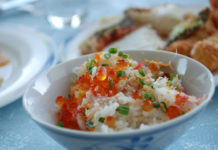Ozoni, or mochi soup, is a Japanese holiday meal traditionally prepared on New Year’s Day. After baking, fresh mochi is put into a bowl, and soup and cabbage are ladled over it. I remember watching my mom make ozoni once by boiling pork bones to create a soup base then adding napa cabbage. There are many different variations of ozoni–what follows below is my recipe.
This was my first attempt at mochi and it came out fabulous. It made me nostalgic, reminding me of my Grandma.
Ingredients:
Dried mochi*
Kamaboko* (steamed Japanese fish cake)
Napa cabbage
Fresh renkon* (lotus root)
Carrot
Chicken on the bone
Konbu* (seaweed)
*can be found in the Asian section of most supermarkets or at a specialty Asian supermarket.
Instructions:
Bring about 6 cups of water to a boil then add the chicken bones and pieces of konbu seaweed. Reduce heat and cook on medium heat for about 30 minutes. While the broth cooks, periodically skim it to remove fat and oil from the surface. When it is done, add salt and freshly ground black pepper to taste.
Remove the chicken bones from the water and carefully remove the small bits of meat as well. You will add the meat back into the soup later.
Cut the carrots into thin slices using a Japanese metal vegetable cutter (similar to a cookie cutter but much smaller), if you have one, into a sakura (cherry blossom) shapes. If you don’t have one, very think slices of round carrot will do. Steam the sliced carrots for about 4 minutes and set aside until serving.
Renkon is a mild flavored root that has a nice crisp texture to it. It reminds me a lot of jicama. Peel the fresh renkon with a potato peeler and slice it thin. Place it into a bowl filled with cool water and a splash of white vinegar to keep the renkon from darkening. After steaming the carrots, add more water to the pot and steam the renkon slices. These take longer, about 10 minutes. Set aside until serving. While the renkon is cooking, turn the oven on to 300 degrees to preheat for the mochi.
Wash and slice the napa cabbage leaves. Add the pieces with the thick white stalk to the soup broth first and allow to simmer for a few minutes. Add the rest of the leaves shortly after and simmer for a few minutes before serving the soup.
While the cabbage is cooking, place the dried mochi on a cookie sheet and bake at 300 degrees until the outside crisps and the inside puffs up–this takes just a few minutes.
Kamaboko is a steamed fish cake that comes in various shapes but it is often colored in a white with pink combination. It is found in the refrigerated section of Japanese and Asian grocery stores. Just a minute before serving, add the sliced kamaboko to the soup base.
Right before serving, remove the konbu that you used to make the soup base. Add the carrot, chicken and renkon to the soup just before serving.
Now put the mochi in a large serving bowl and ladle the soup over it. Once you’ve added your hot soup broth to the bowl you can tear small pieces of mochi off using pointed chopsticks to eat with. Interesting fact: Japanese chopsticks have very sharp ends while Chinese chopsticks are more rounded and blunt at the tips.
A Word of Caution:
Mochi is cooked sweet rice that is pounded into a sticky mass. The result is that mochi is very sticky and if too big of a bite is swallowed without proper chewing, it is very easy to choke, even to death, on a bite of mochi. Mochi can be very dangerous for children to eat due to its chocking hazard. Parents should cut the mochi into very small pieces for children old enough to understand they must carefully chew and swallow each piece before eating another. My parents gave us mochi and mochi soup as children but only under the most attentive guidance to reduce this hazard. For children, substituting tofu for mochi is a good alternative.
Notes and Modifications:
Please make sure you see our above note on the choking hazard of mochi, especially for young children. You can also substitute tofu for the mochi if mochi is not available or you are serving it to young children.
You can also use a brown rice mochi like Grainaissance, Mitoku or Eden brands. It is healthier as the rice is unrefined but for the holiday, I used the traditional white rice mochi, just for old times sake.
From Stacie Tamaki’s The Flirty Guide


































